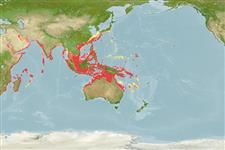Common names from other countries
Environment: milieu / climate zone / depth range / distribution range
Ökologie
seewasser; brackwasser riff-verbunden; tiefenbereich 10 - 120 m (Ref. 12260). Subtropical; 35°N - 27°S, 32°E - 168°E
Indo-West Pacific: Red Sea to New Caledonia; north to Japan. Invaded the eastern Mediterranean from the Red Sea through the Suez Canal.
Length at first maturity / Size / Gewicht / Alter
Maturity: Lm ?, range 14 - ? cm
Max length : 22.5 cm TL Männchen/unbestimmt; (Ref. 118193); common length : 18.0 cm TL Männchen/unbestimmt; (Ref. 30573); max. veröff. Alter: 5 Jahre (Ref. 12065)
Rückenflossenstacheln (insgesamt): 8; Rückenflossenweichstrahlen (insgesamt): 9; Afterflossenstacheln 1; Afterflossenweichstrahlen: 7. This species is distinguished by the following characters: D VIII,9; pectoral fins 14-16; gill rakers 7-8 + 18-20 = 26-27; lateral line scales 33-35; body depth at first dorsal-fin origin 24-26% SL and at anus 21-23% SL; caudal-peduncle depth 9.0-10% SL; maximum head depth 20-22% SL; head depth through eye 16-17% SL; head length 27-29%SL; orbit length 7.3-8.9% SL; upper jaw length 11-12% SL; barbel length 15-17% SL; caudal-fin length 27-30% SL; anal-fin height 13-15% SL; pelvic-fin length 17-22% SL; pectoral-fin length 25-27% SL; first dorsal-fin height 20-23% SL; second dorsal-fin height 14-16% SL; 6-8 thin, red caudal fin bars on upper lobe (faintly retained when preserved), none on lower lobe but with a red broad band covering the entire lobe apart from the distal, inner margin, the latter somewhat darker (most of which are lost in preserved fish); one mid-lateral body stripe yellow or gold from eye to upper caudal-fin base (not or faintly retained in preserved fish); dark first dorsal-fin tip (retained in preserved fish); white barbels; silvery-rose body, dorsally darkened above lateral stripe (pale brown, slightly darkened dorsally in preserved fish) (Ref. 82903).
Found in coastal waters with a muddy substrate. Forms large schools (Ref. 9987). Usually fast swimming with short stops to feed (Ref. 48636). Sold fresh in markets. Utilized for fish meal. Valued also for its roe (Ref. 9987).
Uiblein, F. and P.C. Heemstra, 2010. A taxonomic review of the Western Indian Ocean goatfishes of the genus Upeneus (Family Mullidae), with descriptions of four new species. Smithiana 11:35-71. (Ref. 83903)
IUCN Rote Liste Status (Ref. 130435)
CITES (Ref. 128078)
Not Evaluated
Bedrohung für Menschen
Harmless
Nutzung durch Menschen
Fischereien: kommerziell
Mehr Information
PartnerBilderStamps, Coins Misc.LauteCiguateraGeschwindigkeitSchwimmstilKiemenoberflächeOtolithsGehirngrößeSehfähigkeit
Tools
Zusatzinformationen
Download XML
Internet Quellen
Estimates based on models
Preferred temperature (Ref.
115969): 24.3 - 28.2, mean 27.2 (based on 424 cells).
Phylogenetic diversity index (Ref.
82804): PD
50 = 0.5000 [Uniqueness, from 0.5 = low to 2.0 = high].
Bayesian length-weight: a=0.00912 (0.00817 - 0.01018), b=3.10 (3.07 - 3.13), in cm Total Length, based on LWR estimates for this species (Ref.
93245).
Trophic level (Ref.
69278): 3.6 ±0.3 se; based on diet studies.
Widerstandsfähigkeit (Ref.
120179): mittel, Verdopplung der Population dauert 1,4 - 4,4 Jahre. (K=0.65-1.30; tm=1; tmax=5; Fec=1,515).
Fishing Vulnerability (Ref.
59153): Low vulnerability (22 of 100).
